In the early hours of February 29th, the IDF facilitated (for the fourth consecutive night) a convoy of 30 aid trucks which had entered the Gaza Strip via the Kerem Shalom crossing and was making its way to the northern part of the territory. As reported by the Times of Israel and others, at around 04:45 a.m. the convoy was mobbed by locals, resulting in many deaths and injuries.
“The Israel Defense Forces published drone video showing thousands of people swarming around the aid trucks as they reached the area in northern Gaza. In some cases, the vehicles continued to try and push past the crowds.
The trucks were being driven by “private contractors,” the IDF said.
According to an initial IDF probe of the crush, the vast majority of the casualties were a result of trampling and being struck by the aid trucks.
The incident began at around 4 a.m., when some 30 trucks carrying humanitarian aid arrived at the coast of Gaza City, to deliver food to Palestinians in the Rimal neighborhood.
Thousands of Palestinians rushed the trucks after they passed an IDF checkpoint in central Gaza, leading to a stampede in which dozens of Palestinians were killed and hundreds wounded, some after being run over by the trucks, according to the probe.
The IDF’s initial investigation found that some of the trucks managed to continue further north, where armed men reportedly opened fire at the convoy near Rimal and looted it.
Dozens of Palestinians who rushed the last truck in the convoy, further south, began to move toward an IDF tank and troops stationed at the military’s checkpoint, the investigation found.
An officer stationed in the area ordered soldiers to fire warning shots in the air as the Palestinians were within a few dozen meters, as well as gunfire at the legs of those who continued to move toward the troops, the probe said.
The IDF said that fewer than 10 of the casualties were a result of Israeli fire.”
The IDF has stated that an independent investigation into the incident is taking place.
While this particular incident resulted in a high number of casualties, it is by no means the first in which aid trucks have been mobbed or attacked by looters, including organised crime gangs. In addition, humanitarian aid has been stolen by Hamas itself. Already on February 20th, the World Food Programme had announced that it was pausing aid deliveries to the northern Gaza Strip, citing violent incidents.
“On Sunday, as WFP started the route towards Gaza City, the convoy was surrounded by crowds of hungry people close to the Wadi Gaza checkpoint. First fending off multiple attempts by people trying to climb aboard our trucks, then facing gunfire once we entered Gaza City, our team was able to distribute a small quantity of the food along the way. On Monday, the second convoy’s journey north faced complete chaos and violence due to the collapse of civil order. Several trucks were looted between Khan Younes and Deir al Balah and a truck driver was beaten.”
That obviously relevant context was however largely absent from the BBC News website’s extensive coverage of the February 29th incident.
The first BBC News website report on the story was published on the afternoon of February 29th under the headline “Israel-Gaza war: More than 100 reported killed in crowd near Gaza aid convoy”. Written by Paul Adams and David Gritten, its current version opens as follows: [emphasis added]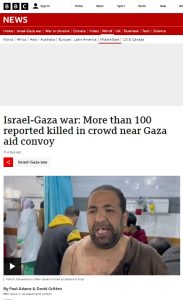
“At least 112 Palestinians are said to have been killed and 760 injured trying to get desperately needed aid in Gaza.
Crowds descended on a convoy of lorries on the coastal road south-west of Gaza City, in the presence of Israeli tanks.
Israel’s military say tanks fired [sic] warning shots but did not strike the lorries, adding many of the dead were trampled or run over.
Hamas rejected Israel’s account, saying there was “undeniable” evidence of “direct firing at citizens”.”
The report goes on to mention the IDF’s statement concerning the incident before telling readers that:
“A Palestinian witness, speaking to the BBC, described panic in the crowd and among the drivers, who tried to move forward. Most of those who died were run over, the witness added.”
Readers also found different accounts:
“One man at the hospital who was cradling the body of his dead friend, Tamer Shinbari, told the BBC he had gone to the Nabulsi roundabout hoping to get a bag of flour for his family. He said Israeli soldiers had opened fire “and the aid lorry ran over the bodies”.
All or most of the casualties being treated at two other hospitals, Kamal Adwan and al-Awda, were said by officials there to have bullet or shrapnel wounds.”
Gritten and Adams found it appropriate to amplify an unevidenced accusation:
“Reacting to Thursday’s incident, Palestinian Authority President Mahmoud Abbas, a rival of Hamas based in the occupied West Bank, accused Israeli forces of a “heinous massacre”.”
On March 1st the BBC News website published a report by Thomas Mackintosh which is now headlined “UN chief urges probe into Gaza aid convoy tragedy” and opens by telling readers that:
“At least 112 people were killed and more than 760 injured on Thursday as they crowded around aid lorries.
Hamas accused Israel of firing at civilians, but Israel said most died in a crush after it fired warning shots.”
That report mention’s the IDF’s statement concerning the incident after telling readers that:
“Ramzi Mohammed Rihan was injured in the stampede and described to BBC Arabic what he saw.
He said: “We were informed that a shipment of flour would arrive through Al-Nabulsi Street and that there would be no shooting.
“We went to get flour to feed our children. We went to Nabulsi Street and before the trucks arrived there was gunfire.
“As the trucks entered, we headed towards them, and as we tried to get the first bag of flour out of the truck, they began to fire at us.””
The BBC does not clarify who “they” were and the report goes on to amplify Hamas propaganda:
“Hamas rejected the IDF’s account, citing “undeniable” evidence of “direct firing at citizens, including headshots aimed at immediate killing”.”
Also on March 1st, a report by BBC Verify titled “What video and eyewitness accounts tell us about Gazans killed around aid convoy” appeared on the BBC News website. Credited to Paul Brown and six others, that item opens by telling BBC audiences that: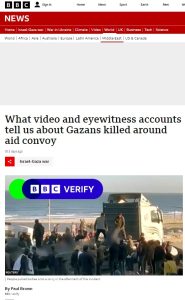
“At least 112 Palestinians were killed as crowds rushed around lorries delivering desperately needed food aid in the small hours of Thursday morning, according to the Hamas-run health ministry.
Hundreds of people descended on the line of vehicles as it travelled in darkness northwards along the coastal road just outside Gaza City, accompanied by the Israeli military.
In addition to the dead, 760 people were injured, the ministry said.
The tragic incident has given rise to differing claims about what happened and who was responsible for the carnage.
BBC Verify has looked at key information – when it emerged and where from. We have examined social media videos, satellite imagery and IDF drone footage to piece together what we know – and don’t know – about what happened so far.”
The report later states:
“Mahmoud Awadeyah, a journalist who was at the scene, told BBC Arabic: “There was a large number of people looking for something to eat and a bag of flour.” […]
Mahmoud Awadeyah said the Israeli vehicles had started firing at people when the aid arrived.
“Israelis purposefully fired at the men… they were trying to get near the trucks that had the flour,” he said. “They were fired at directly and prevented people to come near those killed.””
As reported by David Collier, the eye-witness chosen by the BBC’s fact checking and anti-disinformation department works for Al Quds Today and the Tasnim News Agency – an Iranian news agency set up and controlled by the IRGC.
Writing at the Telegraph, Danny Cohen observed that:
“In other words, it appears that the BBC’s source is on the payroll of a country committed to the genocidal destruction of the Jewish State, one that uses its media proxies to promote its murderous ambitions.
Unfortunately, it gets worse. Mahmoud Awadeyah’s social-media timeline is filled with pro-terrorist and anti-Semitic material. BBC Verify’s source appears to be a man who celebrates the deaths of Jews. […]
Awadeyah’s social-media posts are publicly available for any journalist to see. Yet BBC Verify appears to have failed in the most basic of journalistic practices: checking one of their key sources. How could this have possibly happened?”
On March 2nd the BBC News website published a report by Christy Cooney and Paul Adams headlined “Large number of bullet wounds among those injured in Gaza aid convoy rush – UN” which opens by telling readers that:
“Many of the people treated for injuries following a rush on an aid convoy in Gaza on Thursday suffered bullet wounds, the UN has said.
UN observers visited Gaza City’s al-Shifa Hospital and saw some of the roughly 200 people still being treated.
Hamas has accused Israel of firing at civilians, but Israel said there was a “stampede” after its troops fired warning shots.”
Later, with no reference to the record of UN OCHA, readers are told that:
“Giorgios Petropoulos, head of the Gaza sub-office of the UN Co-ordinator for Humanitarian Affairs (OCHA) told the BBC he and a team sent to al-Shifa hospital found a large number of people with bullet wounds. […]
Mr Petropoulos said those with bullet injuries had suffered wounds in the upper and lower body. One patient told him he had been shot in the chest and had walked to Shifa to get treatment.
“He said they (Israeli troops) usually shoot in the air. This time, they shot into the thickest part of the crowd,” Mr Petropoulos said.
But, Mr Petropoulos emphasised UN personnel had not been present during the incident making it very difficult to know precisely what happened.”
In other words, Adams and Cooney chose to amplify an unverified second-hand claim from an anonymous source retold by someone who was not at the scene.
Three of the four above reports include a video report by Fergal Keane which also appeared on the BBC News website on February 29th under the title “Gaza aid drop: Devastation after more than 100 reported killed at Gaza aid drop”. The same report was aired on the BBC News channel.

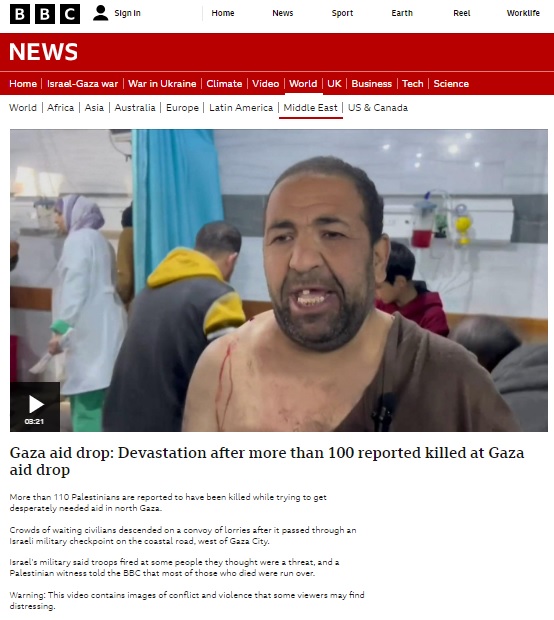
Links to some of those reports also appeared in most of the largely ‘he said – she said’ accounts of the incident that were presented in other BBC News website content.
“Israel Gaza: Seven hostages killed, Hamas says”, Alex Binley, March 1st 2024
“However, there are fears that the announcement of the hostages’ deaths, coupled with the deaths of at least 112 people during a Gaza aid delivery on Thursday, could hamper these talks.
Hamas accused Israel of firing at civilians, but Israel said most died in a crush after it fired warning shots.
After Thursday’s deaths, Hamas warned that talks in Qatar to try and secure a new ceasefire alongside the release of Israeli hostages it is holding could now be jeopardised.”
“Israel Gaza: Biden hopes to see ceasefire by the start of Ramadan”, Max Matza and Christy Cooney, March 2nd 2024
“Calls for action to alleviate the humanitarian crisis in Gaza intensified on Thursday after more than 100 people were killed as crowds rushed around aid lorries delivering food.
Hamas, which governs Gaza, accused Israel of firing at civilians, but Israel said most had died in a stampede after it fired warning shots.”
“Israel-Gaza briefings: Biden treading carefully through political minefield”, Anthony Zurcher, March 2nd 2024
“But with new headlines of civilian bloodshed in Gaza virtually every day, emotions are raw. This week the death toll in Gaza surpassed 30,000, according to the Hamas-run health ministry. And on Thursday at least 117 Palestinians were killed and hundreds were injured during an aid delivery in Gaza.”
“Israel-Gaza war: US carries out its first aid airdrop in strip”, Henri Astier, March 2nd 2024
“At least 112 people were killed as crowds rushed to an aid convoy outside Gaza city on Thursday.
Hamas has accused them [sic] for the killing. Israel denies this and says it is investigating. […]
In Thursday’s incident, 112 people were killed and more than 760 injured as they crowded around aid lorries on the south-western edge of Gaza City.
Israel said most died in a crush after it fired warning shots.
Giorgios Petropoulos, head of the Gaza sub-office of the UN Co-ordinator for Humanitarian Affairs (OCHA) told the BBC that he and a team sent to al-Shifa hospital had found a large number of people with bullet wounds.”
“Fergal Keane: Aid convoy tragedy shows fear of starvation haunts Gaza”, Fergal Keane, March 2nd 2024
“It is essential to know the when, what and how of the tragedy at al-Rashid Street.
Although the precise facts require an independent investigation of a kind not likely in Gaza under current conditions, that should not distract from trying to answer why people risked their lives to gather in the pre-dawn darkness in the middle of a war zone.”
“Children starving to death in northern Gaza – WHO”, George Wright, March 5th 2024
“The deliveries themselves have sometimes turned deadly. Last week, at least 112 Palestinians were reportedly killed when large crowds descended on lorries carrying aid while Israeli tanks were present.
Israel said the tanks fired warning shots but did not strike the lorries and that many of the dead were trampled or run over.
But this has been disputed by Hamas, which said there was “undeniable” evidence of “direct firing at citizens”.”
“US Vice-President Harris presses Israel’s Gantz on aid for Gaza”, uncredited, March 5th 2024
“Last week, at least 112 Palestinians were reportedly killed when large crowds descended on lorries carrying aid while Israeli tanks were present.
Israel said the tanks fired warning shots, but did not strike the lorries and that many of the dead were trampled or run over.
This has been disputed by Hamas, which said there was “undeniable” evidence of “direct firing at citizens”.”
As we see, the BBC generally failed to provide context relevant to this story, particularly in relation to previous incidents in which convoys were mobbed or looted and the theft of aid by Hamas and criminal gangs. It did however repeatedly promote unverified claims from the Hamas terrorist organisation and questionable ‘witnesses’ on an equal footing with statements made by the IDF. BBC audiences were not informed what lies behind Hamas’ efforts to persuade world opinion that a “massacre” was perpetrated by IDF troops who were in fact risking their own lives to facilitate a humanitarian convoy.
Fergal Keane’s March 2nd article includes the following:
“It is still too early to speak of the tragic events of 29 February as a turning point.
But, the deaths of so many in such terrible circumstances have added to the growing pressure for a ceasefire deal that would allow food to reach the hungry.
The coming days will tell if those hopes can be realised.”
That is precisely the aim of the Hamas narrative surrounding this tragic incident. Unfortunately, shoddy and irresponsible journalism such as that by BBC Verify only encourages those propaganda efforts.
Related Articles:
BBC AVOIDS THE ISSUE OF HAMAS THEFT OF HUMANITARIAN AID
BBC REPORT WHITEWASHES SADISTIC HAMAS VIDEO
THE CEO OF BBC NEWS ANSWERS A QUESTION
UNEVIDENCED CLAIMS OF ISRAELI ATTACKS PROMOTED ON MULTIPLE BBC PLATFORMS



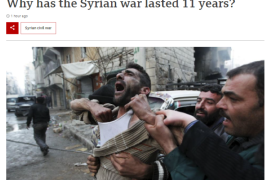

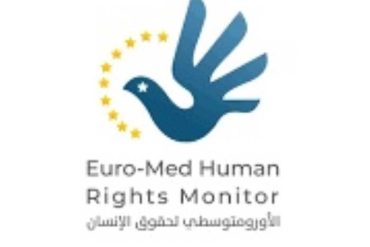
BBC Verify – set up to slander Israel.
We never heard of of it before the 7 October
No other conflict is reported by the BBC where they don’t have feet on the ground in such circumstance to such an extent. Here they rely on journalists who are local and work for Hamas- propaganda journalism- otherwise Hamas would not permit them to operate – the same goes for pictures/videos from “international” non partisan agencies!